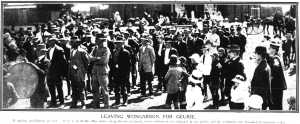Thomas CULLEY
Per his military service record (Depot), Thomas Culley was born at Waterloo, Sydney.[1] He gave his age as 30 years and 5 months, his marital status as married, and his occupation as labourer. His description on his Certificate of Medical Examination was height 5 feet 4 inches tall, weight 142 lbs., with a fair complexion, blue eyes, and grey hair. His religious denomination was Roman Catholic. He claimed that he had no previous military service.
His next of kin was recorded on his Attestation Paper as his wife, Mrs T Culley, 13 Centre Street, Redfern, Sydney, Vic.
Thomas Culley caught a train from Geurie to Orange on a rail ticket issued on 22nd October 1915, where he joined the Coo-ees.[2]
He was named in the Leader as one of the men who enlisted with the Coo-ees at Orange.[3]
He completed his medical examination on 24th October 1915 at Orange. He was attested by Captain T. A. Nicholas at Orange on the same day.
After completing the Coo-ee March he went to Liverpool Camp as reinforcement for the 13th Battalion.
On 7th December 1915 Private Culley was charged with being absent without leave from 3rd December 1915 until 7th December 1916. He was fined 10 shillings.
On 23rd February 1916 Private Culley was charged by Courts Martial with being absent without leave from the Liverpool Camp from 21st December 1915 until 31st January 1916. He was sentenced to 60 days detention.
On the 1st May 1916 Private Culley went absent without leave again at Kiama. On 23rd May he was posted as a deserter and a warrant was issued for his arrest.
The warrant was withdrawn on 30th January 1919.
[1] NAA: B2455, CULLEY T
[2] Letter from Capt. W. T. Hitchen to Superintendent of Lines Sydney dated 4th November 1915 in: Alex Halden (Joe) Miller papers mainly relating to the Gilgandra Coo-ee Recruitment March, New South Wales, 1912-1921, 1939. Gilgandra Coo-ee Recruitment March correspondence and papers, 1915-1939.
[3] THE RECRUITS. (1915, October 25). Leader (Orange, NSW : 1912 – 1922), p. 4. Retrieved November 26, 2016, from http://nla.gov.au/nla.news-article117842599



